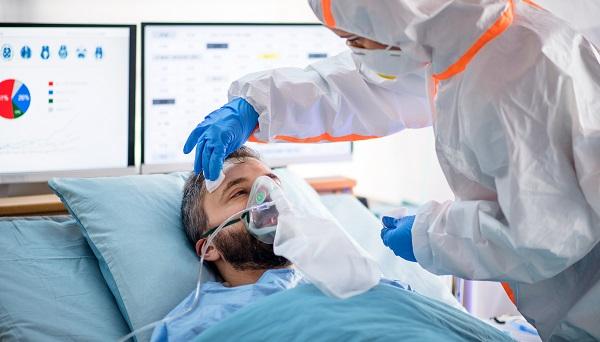Dapagliflozin No Help, but No Harm, in Hospitalized COVID-19 Patients
Full trial results showed numerically lower event rates with the SGLT2 inhibitor and importantly no major signal of ketoacidosis.

Dashing hopes that a sodium-glucose cotransporter 2 (SGLT2) inhibitor already proven to protect the major organs in multiple disease settings might also be of benefit in COVID-19, the DARE-19 trial of dapagliflozin has come up empty-handed.
In this international, randomized, placebo-controlled trial of adult patients hospitalized with confirmed or “strongly suspected” COVID-19, dapagliflozin (Forxiga; AstraZeneca) did not decrease rates of organ failure or death from any cause. Nor did it improve the chances of recovery at 30 days, the trial’s dual primary endpoint.
Mikhail Kosiborod, MD (Saint Luke's Mid America Heart Institute, Kansas City, MO), unveiled the full results at a late-breaking clinical trial session this morning at the American College of Cardiology 2021 Scientific Session. Top-line results were previously released by the study sponsor and reported in TCTMD’s COVID-19 Dispatch.
“Our study generates a hypothesis that dapagliflozin may offer organ protection in acutely ill patients who are hospitalized with COVID-19, but we were not able to prove this beyond a reasonable doubt because patient outcomes rapidly improved during the study period, making it much harder to accrue enough events and reach statistical certainty,” Kosiborod observed.
Taking a DARE in COVID-19
DARE-19 investigators randomized 1,250 subjects with assumed or confirmed COVID-19—50% of whom were diabetic—from 95 sites in seven countries to 10 mg/day of dapagliflozin or placebo at the time of hospitalization. At 30 days, rates of organ failure or death—the prevention outcome—were numerically lower in the dapagliflozin group than the placebo group but did not meet statistical significance (13.8% vs 11.2%; HR 0.80; 95% CI 0.58-1.10). Likewise, for the recovery outcome—a hierarchical composite endpoint balancing improvement, stabilization, or deterioration (categorized as time to discharge before day 30, clinical status if still hospitalized, organ failure, or death)—events were evenly balanced between the dapagliflozin and placebo groups.
For kidney disease and all-cause mortality, the two key secondary endpoints, events were numerically lower for dapagliflozin, Kosiborod noted, but again not statistically significant. In terms of safety, adverse events, including kidney injury, were all numerically lower with dapagliflozin with the exception of diabetic ketoacidosis—a specific concern that has led to widespread recommendations that patients admitted with COVID-19 have their SGLT2 inhibitor stopped. Here, however, only two patients out of 625 developed this particular side effect.
“Treatment with dapagliflozin did not achieve statistical significance for the dual primary endpoints,” Kosiborod concluded. “However, numerically fewer patients treated with dapagliflozin experienced organ failure and death, and this was consistent across components including respiratory, cardiovascular, kidney complications, and death. Dapagliflozin was well tolerated, with numerically fewer serious adverse events than placebo.”
Regarding the concerns that continuing SGLT2 inhibitors in COVID-19 patients could increase the risk of acute kidney injury and ketoacidosis, the DARE-19 results “do not support discontinuation of SGLT2 inhibitors in the setting of COVID-19, as long as patients are monitored,” Kosiborod said.
Useful Knowledge
Both trial discussant James Januzzi Jr, MD (Massachusetts General Hospital, Boston), as well as Ana Barac, MD, PhD (MedStar Heart and Vascular Institute, Washington, DC), who weighed in on the trial findings during a media briefing, zeroed in on the reassurance provided by the safety data, specifically with regard to ketoacidosis. This finding “may be one of the most important outcomes” of DARE-19, Januzzi suggested, while Barac likewise observed: “Your very careful analysis, I think, helps clinicians to [understand] this risk in a new light and to know that often it’s not going to lead with harm and it might be associated with benefit to continue.”
Studies like DARE-19 trial remain critically important because hospitalized COVID-19 remains highly morbid, with nearly 14,000 deaths just yesterday alone. James Januzzi Jr.
Barac also pointed out that the SGLT2 inhibitor class of medication, originally developed for diabetes, has already showed benefits in heart failure and CV event reduction. DARE-19 won’t be practice changing in COVID-19, she suggested—beyond the advice to not stop the drugs in people already taking them—but “it really becomes exciting and hypothesis-generating for a number of investigators and clinicians in the area of cardiometabolic health,” she told Kosiborod. “I think what your trial does is it moves the investigation also in the field of acute illness where hazards and risk are different, and I think it will be followed by future investigations.”
Like Kosiborod, Januzzi also made the observation that, for the recovery outcome, dapagliflozin may have kept some patients from dying and, as such, extended their hospital stay, thus potentially muddying this endpoint.
Bigger Trials, Larger Questions
During the question and answer following the late-breaking presentation, Januzzi pointed out that the nonsignificant signal of benefit for dapagliflozin for the prevention component of the primary endpoint hinted that trial size might have been insufficient to demonstrate a real effect, asking Kosiborod if he’d done the math to understand what size of trial might have produced a different result.
If all else stayed the same, Kosiborod replied, a trial of 3,000 might yield a minimal detectable effect, while a trial closer to 5,000 would be needed for 80% power.
“Just for context, everyone,” Januzzi reminded the late-breaking audience, “a study size of 5,000 sounds large, but yesterday globally, there were 836,000 cases of COVID-19, which comes down to approximately 580 per minute. So it is certainly reasonable to expect that a study of that size would be feasible.”
Beyond COVID-19, DARE-19 raises the possibility of testing the organ-protection effects of dapagliflozin in other acute illnesses. “I think in order to prove it definitively, we’d need to do trials that would accrue substantially higher numbers of events to have statistical certainty and a definitive answer,” Kosiborod observed. Sepsis, he suggested, would be a reasonable target.
Stepping back from the specifics of the DARE-19 results, Januzzi had another sober message for his virtual ACC viewers. The DARE-19 investigators, he pointed out, pulled off a rigorous, timely, multinational, randomized controlled trial in the middle of an evolving pandemic when many thought such a thing was impossible.
“We were therefore left with a large number of small, very often single-center studies that were grossly underpowered and with results that were dubious at best,” Januzzi said. “Unfortunately, the medical literature was flooded with often contradictory data regarding therapies that are presently no longer considered viable but still sometimes are administered because of confusion among patients, families, and in some cases physicians. So even with improvements in management, studies like DARE-19 trial remain critically important because hospitalized COVID-19 remains highly morbid, with nearly 14,000 deaths just yesterday alone.”
Shelley Wood was the Editor-in-Chief of TCTMD and the Editorial Director at the Cardiovascular Research Foundation (CRF) from October 2015…
Read Full BioSources
Kosiborod M. Dapagliflozin In Patients Hospitalized with COVID-19. Presented at ACC 2021. May 16, 2021
Disclosures
- DARE-19 was funded by AstraZeneca
- Kosiborod reports research grants from AstraZeneca and Boehringer Ingelheim and serving as a clinical trial leader or consultant for AstraZeneca, Applied Therapeutics, Amgen, Bayer, Boehringer-Ingelheim, Eli Lilly, Janssen, Merck (Diabetes), Novo Nordisk, Sanofi, and Vifor Pharma.





Comments